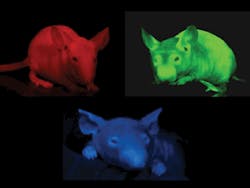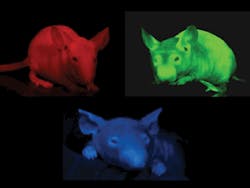Tumors fluoresce before turning deadly
A Vanderbilt University (Nashville, TN) team has developed novel imaging agents able to light up tumors before they turn deadly, monitor a tumor's transition from premalignancy to aggressive growth, and to define tumor margins during surgical removal.1 The compounds are fluorescent inhibitors of cyclooxygenase-2 (COX-2), an enzyme that increases during cancer progression in virtually all solid tumors and is an attractive target for molecular imaging. COX-2 is not found in most normal tissues but is "turned on" at the earliest stages of premalignancy, explains Lawrence Marnett, Ph.D., who led the team.
Mice with the mutation that causes familial adenomatous polyposis in humans develop small intestinal tumors that light up when the mice receive fluorocoxib injections. (Image courtesy Lawrence Marnett and colleagues)
Marnett and his colleagues previously demonstrated that fluorescent COX-2 inhibitors–"fluorocoxibs"–were useful probes for protein binding, but their early molecules were not appropriate for cellular or in vivo imaging. To further develop them, Jashim Uddin, Ph.D., started with the "core" chemical structure of the anti-inflammatory medicines indomethacin and celecoxib. He then tethered various fluorescent parts to the core structure, ultimately synthesizing more than 200 compounds. The group tested each one for its interaction with purified COX-2 and COX-1 proteins, and then assessed promising compounds for COX-2 selectivity and fluorescence in cultured cells and in animals. Two compounds made the cut, and were verified for in vivo imaging using three different mouse models.
To move the agents toward human clinical trials, the team will do more testing, and develop them for particular settings amenable to fluorescence imaging, such as skin or sites accessible by endoscope.
In the esophagus, for example, a premalignant lesion called Barrett's esophagus can transition to a low-grade dysplasia, then to a high-grade dysplasia, and finally to malignant cancer, which has a one-year survival rate of only 10%. Detecting the transition to dysplasia is critical for treatment, but dysplasia is not visibly different from a premalignant lesion. Today, physicians collect random biopsy samples–which might miss areas of dysplasia–but if they could see a nest of cells lighting up through an endoscope, they could biopsy with greater precision.
- J. Uddin et al, Cancer Res., 70: 3618–3627, 2010.
More Brand Name Current Issue Articles
More Brand Name Archives Issue Articles

